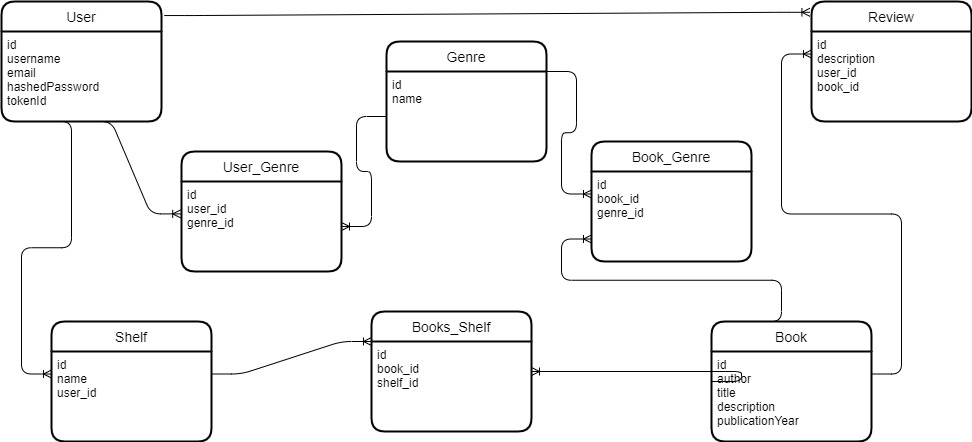This is the repository for the Solo React project.
- Back End
- Express Node.js pg Sequelize
- Front End
- JavaScript React Redux Hooks
-
Clone this repository
git clone`https://github.com/xxl4tomxu98/Mybooks-React-Redux.git` -
Install dependencies (
npm install)$ npm install
-
Create a .env file based on the example with proper settings for your development environment
- CREATE USER mybooks_app WITH PASSWORD <<good password>> - CREATE DATABASE mybooks_db WITH OWNER mybooks_app -
Setup your PostgreSQL user, password and database and make sure it matches your .env file with CREATEDB privileges
PORT=8080 DB_USERNAME=mybooks_app DB_PASSWORD=<<your good password>> DB_DATABASE=mybooks_db DB_HOST=localhost JWT_SECRET=<<good secret code>> JWT_EXPIRES_IN=604800 (**about a week**) -
Run
npm run db:createnpx dotenv sequelize db:createnpm run db:migratenpx dotenv sequelize db:migratenpm run db:seed:allnpx dotenv sequelize db:seed:allnpm start
browse to http://localhost:8080
Books can be added to bookshelves two ways: the dropdown from /user/shelves page where the bookshelves are located, or the books details page (/books/:bookId) after searching for a particular book. It's important to highlight that books can not appear multiple times on the same bookshelf. This is ensured by doing a query in the Back End /api/books/:bookid/shelves route for the bookshelf dropdown select field that filters out bookshelves the books already belongs to.
// api/books.js file
//code grabs all shelves for user with book and all shelves in db then filters out all shelves by excluding
//the shelves found for the user with the book
router.get("/:bookid/shelves",
authenticated,
asyncHandler(async (req, res) => {
//get all the open shelves where the book is not currently on
const bookId = req.params.bookid;
//all shelves for the user that have the specified book
const shelves = await Shelf.findAll({
where: {
userId : req.user.id,
},
include: {
model: Book, where: {
id: bookId
}
}
});
//all shelves in db for the user
const allShelves = await Shelf.findAll({
where: {
userId: req.user.id
}
});
//shelf id's for all user shelves with specific book
let includedShelf = [];
for (let shelf of shelves) {
includedShelf.push(shelf.id);
};
//array of all shelves in db
let allShelvesArray = [];
for (let shelf of allShelves) {
allShelvesArray.push(shelf);
};
//filters array for all shelves in db to have all
//shelves that don't contain the book already
const allShelvesWithoutBook = allShelvesArray.filter(function(shelf) {
if (!includedShelf.includes(shelf.id)) {
return shelf;
}
});
//return as an obj containing the filtered array of objects
res.json(allShelvesWithoutBook);
}));
Note:
- All the shelves for the user are found first. Then the list of shelves with the book included. That list is then converted to id's which is easier to manage later opposed to the shelf object from the db. The array of id's are then used to filter out all of the bookshelves that include that id by cross referencing them with the original query of all the user bookshelves.
- Frontend components/BookDetail.js matches selected shelf name and converted to shelfId for React/Redux treatment
handleSubmit = async (event) => {
event.preventDefault();
try {
const bookId = this.props.match.params.id;
const shelfName = this.state.selection;
const shelves = this.props.openShelves;
const found = shelves.find(shelf => shelf.name === shelfName);
const shelfId = found.id;
await this.props.getShelfDetail(shelfId);
await this.props.addBookToShelf(bookId, shelfId);
this.props.history.push(`/shelves/${shelfId}`);
} catch(e) {}
}The Back End /api/books route handles the search feature. The searchbar encompases the form:
//- searchbar.js file
const [term, setTerm] = useState('');
const history = useHistory();
const updateTerm = (e) => {
setTerm(e.target.value);
}
const handleSubmit = (e) => {
e.preventDefault();
searchBooks(term);
}
const searchBooks = async (term) => {
const res = await fetch(`/api/books/search/${term}`)
if (res.ok) {
const data = await res.json();
history.push({
pathname: '/search',
state: data,
});
return data;
}
throw res;
}The API to route /api/books, which accepts a GET req with the search term as parameter in the end point, gets extracted. The search term is then use to query all book resources in the db that house the search term in it's title, case insensitive ofcourse.
/api/books.js
router.get('/search/:term', asyncHandler(async (req, res) => {
//const { term } = req.query;
let term = req.params.term;
let books;
if (term) {
try {
books = await Book.findAll({
where: {
[Op.or]: [
{ title: { [Op.iLike]: `%${term}%` } },
{ author: { [Op.iLike]: `%${term}%` } }
]
},
order: [['title', 'ASC']]
});
} catch (err) {
console.log(err);
}
} else {
books = await Book.findAll({
limit: 30,
order: [['title', 'ASC']]
})
}
//const searchTitle = `Search result for "${term}"`
//res.render('searchpage', { books, searchTitle });
res.json(books);
}))- Create a new project
- Under Resources click "Find more add-ons" and add the add on called "Heroku Postgres"
- Install the Heroku CLI
- Run
$ heroku login - Add heroku as a remote to this git repo
$ heroku git:remote -a mybooks-react-redux - Push the project to heroku
$ git push heroku master - Connect to the heroku shell and prepare your database
$ heroku run bash
$ sequelize-cli db:migrate
$ sequelize-cli db:seed:all(You can interact with your database this way as youd like, but beware that db:drop should not be run in the heroku environment)
-
Add a
REACT_APP_BASE_URLconfig var. This should be the full URL of your react app: i.e. "https://mybooks-react-redux.herokuapp.com" -
profit

